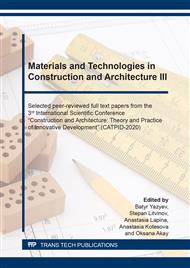p.14
p.23
p.31
p.37
p.44
p.52
p.59
p.66
p.72
The Study of the Quartz Sand Bio Consolidation Processes as a Result of Carbonate Mineralization by Urolithic Bacteria
Abstract:
The complexity and a large number of variable factors of the bacterial carbonate mineralization process in the cement stone system, which is a polylineal and polydisperse system, has led to the question of each component’s role in bio consolidation processes. For carbonate biomineralization occurring in cement concrete during its restoration, it is impossible to fully describe the bio consolidation mechanism without studying the effect on individual components of the cement system (aggregate and binder). In the environment of quartz sand (the most common type of aggregate in cement concrete) there is no direct source of calcium, which is found in cement stone, which excludes the influence of abiotic factors (alkalinity of the medium) on the calcium carbonate production by bacterial cultures. This article presents the results of the study of carbonate biomineralization by urolithic bacterial cultures in a filler medium, in which quartz sand of three fractions (1.25–0.63; 0.63–0.315; 0.315–0.16) was used to assess degree and intensity of induction processes. As a result of the study, the physical and chemical factors of the bacterial carbonate mineralization process intensification in quartz sand samples were established. The time boundaries of the appearance of a consolidated layer were revealed within two fractions (0.63–0.315 and 0.315–0.16), which are directly related to the penetration depth of the solution with precursors and the bacterial inoculum by the percolation method. The analysis of the cemented layers’ microstructure is carried out, the features of neoplasms are considered. The type of bacterial culture that exhibits the most active cementing properties - Bacillus pumilus (VKM B-23).
Info:
Periodical:
Pages:
44-51
Citation:
Online since:
September 2020
Authors:
Price:
Сopyright:
© 2020 Trans Tech Publications Ltd. All Rights Reserved
Share:
Citation:


